Isfrid of Ratzeburg | |
|---|---|
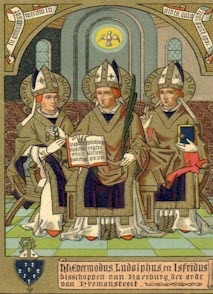 | |
| Prince-Bishop of Ratzeburg | |
| Died | 15 June 1204 Ratzeburg, Schleswig-Holstein |
| Venerated in | Roman Catholic Church |
| Feast | 15 June |
Isfrid of Ratzeburg was a Premonstratensian Prince-Bishop of Ratzeburg. [1]
Isfrid of Ratzeburg | |
|---|---|
 | |
| Prince-Bishop of Ratzeburg | |
| Died | 15 June 1204 Ratzeburg, Schleswig-Holstein |
| Venerated in | Roman Catholic Church |
| Feast | 15 June |
Isfrid of Ratzeburg was a Premonstratensian Prince-Bishop of Ratzeburg. [1]
Isfrid was a professed canon of the Cappenberg monastery in Westphalia. In 1159, Isfrid was appointed the Provost of Jerichow. There he finished construction of the Romanesque collegiate church of St. Mary and St. Nicholas. [2] In 1179, he succeeded Evermode of Ratzeburg as third bishop of Ratzeburg. [3] He was known for his organizational skills and created many parishes.
He was responsible for the restoration of the monastery of Floreffe, near Namur, which had been destroyed by fire. According to Arnold of Lübeck, he succeeded in recalling all the canons that had been scattered in all directions over the past year and a half. He then consecrated the collegiate church of Postel in Belgium, then under the jurisdiction of Floreffe. [2] The ancient annals of Stederburg present him as a man exalted for Christian wisdom, humility and fortitude. [4] Many miracles are associated with Isfrid's life.
He died on 15 June 1204, the day on which his memory is celebrated. In the diocese of Osnabruck he enjoyed an ancient cult, confirmed in 1725 by Pope Benedict XIII to the Order of Premonstratensians. [4] He is depicted as a bishop, with water that turned into wine and with a blind man that he healed. [2]

Norbert of Xanten, O. Praem (Gennep-Magdeburg), also known as Norbert Gennep, was Archbishop of Magdeburg, founder of the Premonstratensian order of canons regular, and is venerated as a saint in the Catholic Church. Norbert was canonized by Pope Gregory XIII in the year 1582, and his statue appears above the Piazza colonnade of St. Peter's Square in Rome.

The Order of Canons Regular of Prémontré, also known as the Premonstratensians, the Norbertines and, in Britain and Ireland, as the White Canons, is a religious order of canons regular of the Catholic Church founded in Prémontré near Laon in 1120 by Norbert of Xanten, who later became Archbishop of Magdeburg. Premonstratensians are designated by OPraem following their name.
The Canons Regular of St. Augustine are Catholic priests who live in community under a rule and are generally organised into religious orders, differing from both secular canons and other forms of religious life, such as clerics regular, designated by a partly similar terminology. As religious communities, they have laybrothers as part of the community.

Titchfield Abbey is a medieval abbey and later country house, located in the village of Titchfield near Fareham in Hampshire, England. The abbey was founded in 1222 for Premonstratensian canons, an austere order of priests. The abbey was a minor house of its order, and became neither wealthy nor influential during its three centuries of monastic life; the inhabitants were devoted to scholarship, as shown by their very impressive library.
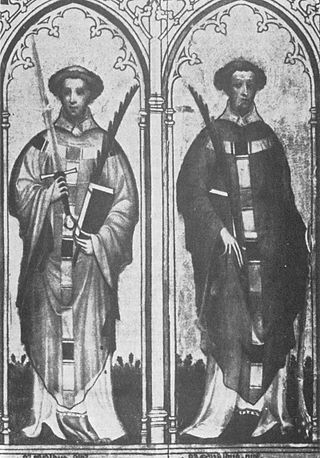
The Two Ewalds were Saint Ewald the Black and Saint Ewald the White, martyrs in Old Saxony about 692. Both bore the same name, but were distinguished by the difference in the colour of their hair and complexions. They began their mission labours about 690 at the ancient Saxons country, now part of Westphalia, and covered by the dioceses of Münster, Osnabrück, and Paderborn. They are honored as saints in Westphalia.

Evermode, or Evermod, was one of the first Premonstratensian canons regular, and became the lifelong companion of Norbert of Xanten, who founded the order in France in 1120. He is sometimes referred to as the "Apostle of the Wends".
Mont Cornillon Abbey was a Premonstratensian monastery which occupied a site in Wallonia close to Liège, Belgium. In 1288 the abbey having moved to a new location, it became known as Beaurepart Abbey. It was the home of Saint Juliana of Liège.

Floreffe Abbey is a former Premonstratensian monastery, the second of the order to be founded, situated on the Sambre at Floreffe, about 11 km (6.8 mi) south-west of Namur, Wallonia, Belgium.

Prémontré Abbey was the mother house of the Premonstratensian Order and was located at Prémontré about twelve miles west of Laon, département of Aisne, France.
The Diocese of Ratzeburg is a former diocese of the Catholic Church. It was erected from the Diocese of Oldenburg c. 1050 and was suppressed in 1554. The diocese was originally a suffragan of the Archdiocese of Hamburg; in 1072 it became a suffragan of the merged entity — the "Archdiocese of Hamburg and the Diocese of Bremen". The territory of the diocese was located in what is today the states of Schleswig-Holstein and Mecklenburg-Vorpommern in Germany. The cathedral church of the diocese — dedicated to Ss. Mary and John — is still extant in the city of Ratzeburg. Following its suppression as part of the Protestant Reformation, the remaining Catholic adherents were only represented by the Apostolic Vicariate of Northern Germany. The whole territory of the diocese is today included in the Roman Catholic Archdiocese of Hamburg.

Marchtal Abbey is a former Premonstratensian monastery in Obermarchtal in the Alb-Donau-Kreis, Baden-Württemberg, Germany. The minster church of Saints Peter and Paul, the former abbey church, located on a prominent elevation, still dominates the landscape for miles around.
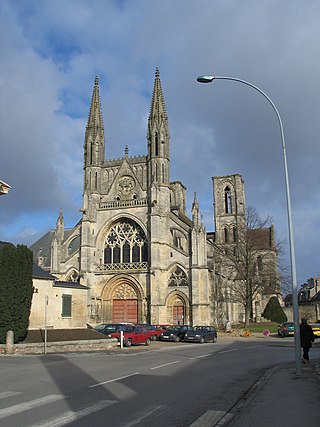
The Abbey of St. Martin, Laon, established in 1124 in Laon in the modern department of Aisne in northern France, was one of the earliest foundations of the Premonstratensian Order. Along with Cuissy Abbey and Floreffe Abbey it counted as one of the primarii inter pares, or senior houses, of the order.

Tupholme Abbey was a Premonstratensian abbey close to the River Witham some 10.5 miles (16.9 km) east of the city of Lincoln, England and one of nine such abbeys within the historical county. The Witham valley in Lincolnshire is notable for its high concentration of monasteries—there were six on the east bank and three on the west—all presumably drawn to the area by the usefulness of the River Witham for transport and by the wealth that it transported. The abbey was largely destroyed by 1538, after being seized during Henry VIII's Dissolution of the Monasteries.
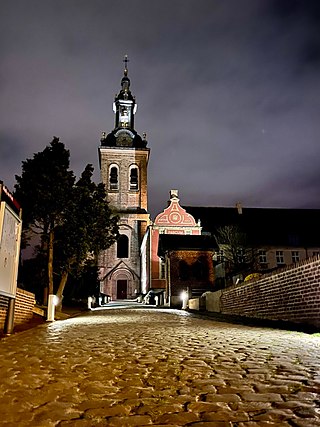
Park Abbey is a Premonstratensian abbey in Belgium, at Heverlee just south of Leuven, in Flemish Brabant.

Bonne-Espérance Abbey was a Premonstratensian abbey that existed from 1130 to the end of the 18th century, located in Vellereille-les-Brayeux in the Walloon municipality of Estinnes, province of Hainaut, Diocese of Tournai, in present-day Belgium.
St. Philip's Priory situated on New London Road in Chelmsford, Essex, UK was a Premonstratensian priory of canons regular. It was dedicated to Our Lady Queen of Sorrows and St. Philip Benizi. In the summer of 2022, the canonry relocated to London, founding the Priory of Our Lady of Sorrows, Peckham, in the Archdiocese of Southwark. St Philip's returned to the care of the Diocese of Brentwood.
Sulby Abbey was a Premonstratensian house in Northamptonshire, England, founded in 1155 as daughter house of the Abbey of St. Mary and St. Martial in Newsham.

Barthélemy de Jur was a French bishop. He was bishop of Laon from 1113 to 1151. Some documents give his name as Barthélemy de Grandson or de Joux.

Daylesford Abbey is a Roman Catholic monastery of Canons Regular of Premontre, located in Chester County, Pennsylvania, about 20 miles west of Philadelphia. The Abbey is named after Daylesford, Pennsylvania, where the Norbertine Fathers established the foundation that developed into the Abbey.
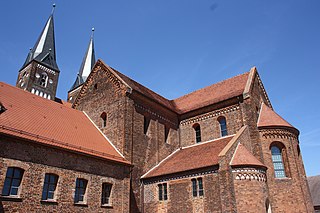
The Jerichow Monastery is a former Premonstratensian monastery located in the northern outskirts of Jerichow, near the shores of the Elbe River, in the state of Saxony-Anhalt of Germany.